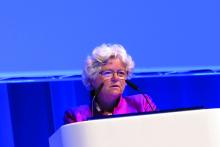AMSTERDAM – Rituximab maintenance therapy did not significantly prolong disease-free survival among patients with diffuse large B-cell lymphoma in complete remission after induction chemotherapy, investigators in the HOVON-Nordic trial collaboration found.
Among 380 patients with diffuse large B-cell lymphoma (DLBCL) in complete remission following induction chemotherapy with R-CHOP (rituximab, cyclophosphamide, doxorubicin, vincristine, and prednisone), the median disease-free survival (DFS) after a median follow-up of 79.9 months had not been reached for patients randomized to either rituximab maintenance therapy or observation alone, reported Pieternella J. Lugtenburg, MD, PhD, from Erasmus Medical Center in Rotterdam, the Netherlands.
“In patients with diffuse large B-cell lymphoma in first complete remission after R-CHOP induction therapy, rituximab maintenance therapy does not prolong disease-free survival, and we could not identify a clinical subgroup that benefited,” she said at the annual congress of the European Hematology Association.
The randomized, phase 3 HOVON-Nordic LG trial compared R-CHOP-14 with rituximab delivered on day 1 for four cycles in one arm, and on days 1 and 8 in the comparison arm (R2-CHOP). Patients were assessed for response after four cycles, and those with progressive disease were taken off the study. The remaining patients continued on their assigned regimen for an additional four cycles and second assessment, and those who had complete responses then underwent a second randomization to rituximab maintenance or observation. Patients randomized to maintenance could receive up to 12 8-week cycles.
The second randomization was stratified by age (18-65 vs. 66-80 years), age-adjusted International Prognostic Index score, and R-CHOP regimen (one or two infusions per cycle in the first randomization).
The induction phase found no significant benefit for the additional rituximab infusion for the primary endpoint of progression-free survival, with 3-year PFS rates of 74% for R-CHOP and 71% for R2-CHOP. Respective 5-year PFS rates were 68% and 62%.
There were no differences between the arms by any of the stratification factors, and no difference in overall survival.
Dr. Lugtenburg presented results of the maintenance phase, which included all patients in complete remission at least 4 weeks after the last cycle of R-CHOP-14 who did not have rituximab-related adverse events or active infections.
A total of 195 patients were randomized to observation, and 185 to maintenance. Of this latter group, 149 patients received all 12 cycles, with a median duration of exposure of 22.5 months.
As noted, DFS, the primary endpoint for the maintenance phase, was not significantly different between the arms, with 136 events in the maintenance arm versus 134 in the observation arm. A total of 21 patients assigned to maintenance died, and 22 patients assigned to observation died during follow-up.
The respective 5-year DFS rates were 79% and 74%, a difference that was not statistically significant.
There were no significant differences between the arms in either time to relapse or death, and no difference in overall survival.
In the question-and-answer section following her talk, Marek Trnený, MD, from Charles University in Prague, pointed out that, in the NHL 13 study, which looked at rituximab maintenance for patients with DLBCL or follicular lymphoma in first remission, there was an apparent clinical benefit with rituximab maintenance for men with low International Prognostic Index scores, and asked whether Dr. Lugtenburg and colleagues had seen similar trends.
“We knew about this finding, and we really didn’t see any differences between males and females, not only in terms of efficacy, but also in terms of toxicity, they had actually the same rates of toxicity,” she said.
In NHL 13, women had a significantly higher incidence of grade 3-4 adverse events, compared with men.
The study was sponsored by HOVON, the HematoOncology Foundation for Adults in the Netherlands, with additional support from Roche. Dr. Lugtenburg reported consultancy for and research funding from Roche and others. Dr. Trnený reported advisory board activity, research support, and honoraria from Roche and others.
SOURCE: Lugtenburg PJ et al. EHA 2019, Abstract S1559.



